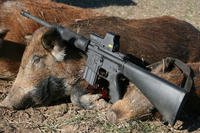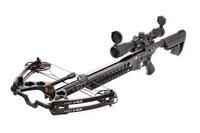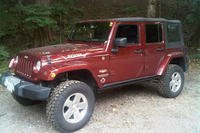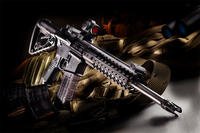The best ways to add power without killing fuel economy.
by G.R. Whale
Campfires, coffee pots and canned beverages frequently trigger debate about what works best, inevitably leading to a mine's-better-than-yours bravado. It doesn't matter if you're talking about guns, gear, scopes or trucks — outdoorsmen like products that work, especially if it gives them an edge over everyone else. Here's a primer on getting more from your pickup or SUV's engine for those of you who like leading the pack instead of being a follower on the road.
Many modern truck performance upgrades are so quick and easy some wonder why it wasn't built that way. Usually it's because the manufacturer had to make compromises to meet fuel economy, durability, noise, emissions and price goals among many other concerns.
The makers of aftermarket performance parts don't need to concern themselves with those issues, so it's easy for them to provide ways to optimize the performance of virtually any truck and most SUVs, whether you consider "optimal" more power, better fuel economy, or both.
The Old Air Pump
While gasoline and diesel engines differ significantly in operation, they are both air pumps at heart so any change that improves intake and exhaust flow is a plus. That's why some of the biggest selling performance upgrades are related to cold-air intakes and cat-back exhausts.
Let's begin on the intake side — at the air filter. High-flow replacement, cleanable air filter elements like those from K&N and Amsoil offer little benefit over a new stock filter. But over time, as the element does its job cleaning the air, the high-flow filters do make a difference, and even when dirty they deliver more airflow so long-term performance improves.
The next step is re-routing the air intake to get a better flow of cooler, denser air to the engine. The cooler the air, the more power the engine makes. Cold-air intake systems are designed to improve air flow and gather air from outside the hot engine compartment.
They work, too. We've seen an average of a nine-horsepower increase at the rear wheels of an Airaid-equipped Tundra 5.7L with no fuel economy gain; a 12hp and an eight percent fuel economy bump on an Airaid-ed TrailBlazer 4.2 inline-six; and 5hp and 10 percent better towing fuel economy and quicker turbo boost on a PowerStroke 6.0L with Volant intake.
With fuel costs currently at more than $3.50 per gallon, cold-air intakes that deliver more than a 5 percent improvement in real-world fuel-economy can pay for themselves in less than 10,000 miles — especially towing or off-pavement miles.
The drawbacks: These systems increase underhood noise under heavy load (they remove the factory noise baffles) and maintenance access to the engine can be a little more difficult.
Boosting Air Pressure
For serious bolt-on power increases, nothing beats adding a turbocharger or supercharger. These systems cram air into the engine, "fooling" it into thinking it's bigger. It's not uncommon to see 100-plus horsepower and torque gains on V6s and V8s — diesel or gas.
There are a number of aftermarket manufacturers that offer superchargers and turbochargers for Ford, GM, Dodge and Toyota products. The kits are expensive, often costing more than $4,000 just for the kit, and they take a lot of time to install. But if you want the fastest and highest gain in power for the dollar for a naturally-aspirated engine, they are the way to go.
The beauty of "forced-induction" is the significant power increases come with minimal economy penalty because the supercharger or turbocharger is working only under heavy-throttle.
All modern diesels are turbocharged, yet sportsmen who need even greater power, say to tow big boats or haul heavy trailers, turbo upgrades abound. Gale Banks Engineering (www.bankspower.com; 800-601-8072) is one of the leaders in this arena, offering full kits for a wide-range of vehicles.
Chip Shots
The second power-boosting arena is altering the vehicle's on-board computer so it supplies more fuel to the engine when your foot heads to the floor. A host of aftermarket parts suppliers offer a means to "tune up" those computers whether with a plug-in chip, computer module, or by "re-flashing" the factory computer.
These White-Glove Hot-rodders revise the factory programming to a make the truck or SUV respond quicker to the throttle demand, waking up the power earlier and for a longer time than the stock computer allows.
But you need to make sure the "programmers" (aka chips, black boxes, power adders, etc.) you are considering include a CARB smog-legal statement, provide driver/installer adjustability, don't interfere with the dealer's diagnostic servicing, and — if it has a display — should be easily read in sunlight.
Another thing to consider is some chips, modules and programmers only deliver their maximum power gains when used in conjunction with intake and exhaust upgrades. Ask such questions before you buy.
Diesel Hot-Rodding
Diesels respond really well to electronic hot-rodding changes that alter injection/rail pressure, injector duration and injection timing; "plugging in" another 100 horsepower can be done in minutes.
The key to diesels is monitoring exhaust gas temperature (EGT) so you don't burn holes in the pistons or melt the turbocharger.
You also need to be wary of running too much fuel pressure (many reach 26,000 psi stock). This is one reason most programmers with multiple settings advise towing only at lower power levels — they have the burned pistons in their shops to prove it.
Ideally, you only want to install diesel programmers that you can adjust either in-cab, underhood, or by the computer when the flashing is done. This way you have complete control over which level of performance is required and when.
Also look for systems that provide a digital display of manifold pressure, EGT, and so on, negating the need and expense of additional gauges.
Two good examples of this are the Juice/Attitude kit from Edge Products (www.edgeproducts.com; 888-360-3343) and Bully Dog Power Pup (www.bullydog.com; 866-285-5936). Both allow the driver to dial-in how much power is needed and when by pushing a couple of buttons on a dash-mounted control on the fly.
While shopping for a system, pay close attention to the dyno charts. Those monster gains in power almost always occur at only one point in the rpm range — not from start to finish. So when someone claims their system adds "100hp" it most likely does — but that max power could be at 1,500rpm or 3,000rpm. Lower rpm is better for getting a big load moving quickly, while higher works best for those highway passing and hill climbing situations.
Oh, forget about "stacking" or running modules in tandem — that's strictly for the dragstrip — not the woods. Keep the installation simple and you'll be a happy camper.
Exhaust Upgrades
Exhaust systems, headers, and downpipes (diesels) work on the premise that less restriction means less energy (fuel) is spent getting combustion byproducts out of the engine. Crimped or excessively bent tubing, manifolds and mufflers are the primary culprits restricting optimum engine performance and economy.
Headers replace the stock manifolds with a lighter, better-flowing set of pipes that produce a synergistic effect in scavenging gases from the cylinders; these are more expensive, don't hold as much heat, and typically noisier than the standard cast-iron manifolds. But you can expect horsepower gains in the 8- 10-percent range.
Replacing the exhaust from the catalytic converters (cat-back) to tailpipe is a much more cost-effective way to gain power — and possibly fuel economy — on some trucks and SUVs.
Swapping to a Magnaflow (www.magnaflow.com; 800.824.8664) exhaust system on an '07 Tundra 5.7L added 16 hp/22 lb-ft to the 300/305 baseline and made a better exhaust tone. But it didn't measurably affect fuel economy.
A few years back I added both Hedman (www.hedman.com; 562-921-0404) headers and a Corsa (www.corsaperformance.com; 800- 486-0999) cat-back to a '98 Dodge Ram 5.9L V8 and it really brought the truck to life — and added nearly 2mpg to fuel mileage.
A Diamond Eye (www.diamondeyeperformance.com; 800-635-9950) single cat-back system on a 6.0L Ford PowerStroke added about 7 hp and 16 lb-ft torque while boosting fuel economy improvement nearly 5 percent.
How a cat-back system and headers work all depend on how good — or how poor — the original exhaust system was designed. The worse the system, the better the results.
Diesel Exhausts
Today's diesel exhaust upgrades are more for keeping EGTs down under heavy pulls, not improving power. Put an upgraded/larger-diameter exhaust on a late-model diesel and the net is only a very minimal increase in fuel economy or power.
That can't be said for pre-‘94 Dodge diesel exhausts and early Ford PowerStroke downpipes, which were quite restrictive — in some cases crushed to 50 percent of diameter — and really hurt output. If you have an older diesel, a modern exhaust can be a big help.
In most cases, however, a fat turbo-back exhaust system isn't beneficial unless accompanied by a performance module or flashing the factory computer. If you do modify your exhaust, pay attention to clearance between the pipe and fuel and brake lines, tanks, shock absorbers, the spare tire and rubber bushings.
Make sure the exit isn't too close to ground or directed at your hitch or trailer — the exhaust gases leaving a hard-working gas engine or a regenerating diesel particulate trap ('07-and-newer diesels) reach 1200° F, potentially melting bits or starting a fire in dry vegetation.
One last words of advice: Don't forget that substantially increasing engine power puts the rest of the driveline — transmission, U-joints, axle gears — at risk of failure. Typically the rear tires break loose first, but when you put a load in the bed or a trailer on the hitch, some other part of the drivetrain becomes the first thing to give, not the tires.
New Life for the Old Dog
Older, carbureted engines still in good shape can benefit from performance intakes and exhausts, plus camshafts that have the " towing," "RV," or "4WD" grinds for best low-end/mid-range performance. It's not unusual to see 30- to 40-percent power gains with the addition of such components.
If you've got an engine that's beyond that and getting tired, but don't want the expense of purchasing, insuring, and servicing a new truck, consider a crate motor from one of the "Big 3" performance divisions. For towing purposes you want "stokers" or engine that build peak torque under 4,000rpm.
Or, for serious towing torque and mileage, Painless Wiring (www.painlessperformance.com; 817-244-6212) has a complete wiring harness to transplant a Cummins 5.9 ISB into just about any pickup or SUV. Just ensure the gearbox and axles of the recipient truck can handle it.
















